North America In-Store Analytics Market Size
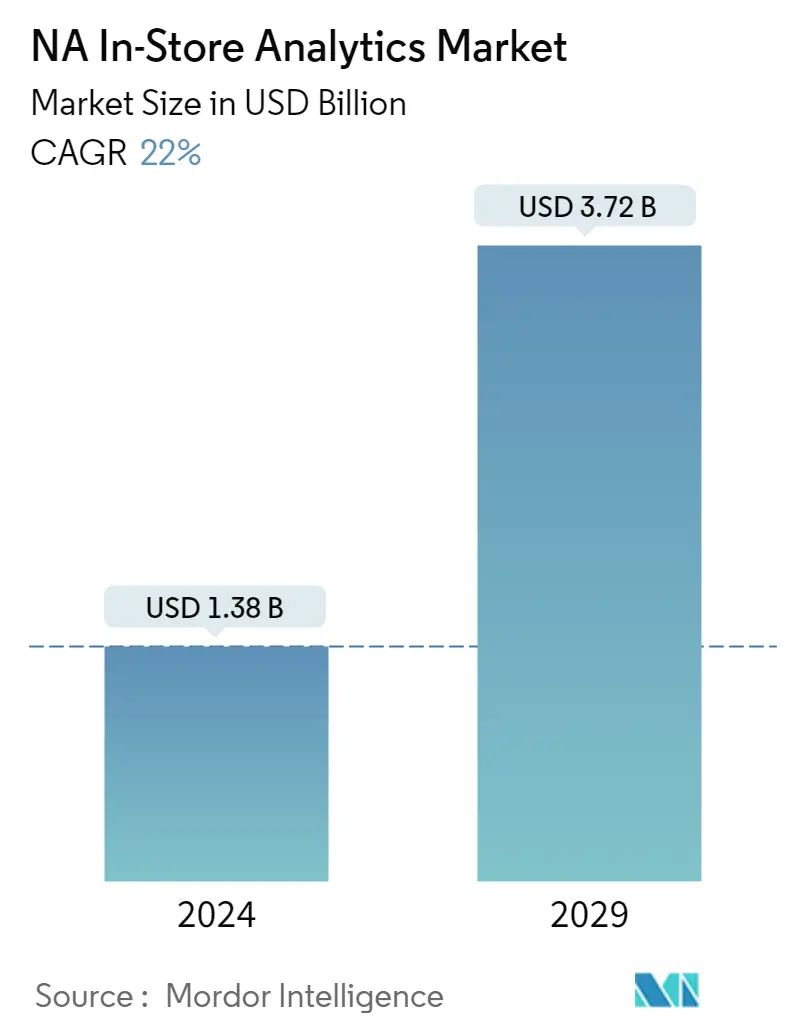
| Study Period | 2019 - 2029 |
| Base Year For Estimation | 2023 |
| Market Size (2024) | USD 1.38 Billion |
| Market Size (2029) | USD 3.72 Billion |
| CAGR (2024 - 2029) | 22.00 % |
| Market Concentration | Low |
Major Players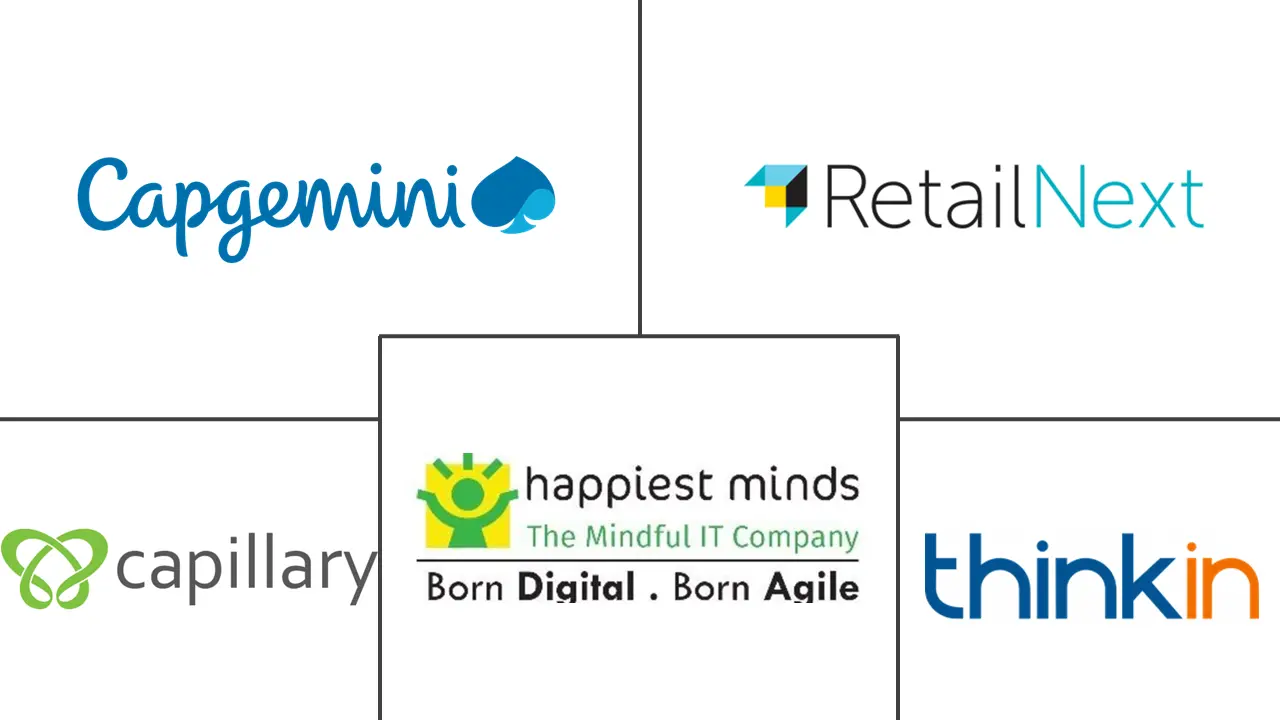
*Disclaimer: Major Players sorted in no particular order |
North America In-Store Analytics Market Analysis
The NA In-Store Analytics Market size is estimated at USD 1.38 billion in 2024, and is expected to reach USD 3.72 billion by 2029, growing at a CAGR of 22% during the forecast period (2024-2029).
Factors such as increasing data volume in in-store operations and the need For better customer service and enhanced shopping experience are expected to drive the market.
- In the hyper-competitive retail market, in-store analytics is gaining traction. In-store analytics has the potential to transform the store layout and improve customer experience across different business segments. In the North American region, retailers use smart carts with location beacons, pin-sized cameras installed near shelves, or the store's Wi-Fi network to see how many shoppers entered the store, how they moved around once inside, and what key areas they visited. This process can provide basic demographic data, such as gender and age group.
- The retail market in North America is one of the biggest. Wal-Mart, Costco, Kroger, Home Depot, and Target originated in this region. The rapidly growing data volume across in-store operations drives the market's growth. With increasing sales value, the volume of data is increasing. With growing data volume, it has become difficult to track every customer's record, behaviors, footfall, etc., without implementing analytics.
- When retailers give customized experiences to their consumers using several technologies, such as evaluating customer preferences, recognizing customer location in-store, targeted promotions, and purchase habits, they accomplish digitalization in shops. The business monitoring technology analyzes these trends to offer valuable insights that assist merchants in increasing sales, revenue, and footfalls. For example, Amazon announced the debut of its new Store Analytics service in June 2022. The e-commerce behemoth is attempting to profit from its physical storefronts by providing marketers with data on what customers buy.
- The United States Bureau of Labour Statistics estimated the demand for skilled and knowledgeable data scientists to boost by 2026, leading to a 27.9% rise in employment. However, this huge demand would also bring a significant shortage of qualified professionals. Further, another challenge to the market growth is that marketers might need to find new ways of executing their strategies in 2022 and beyond to satisfy the consumer thirst for convenience. New data privacy regulations like the California Consumer Privacy Act and Virginia's Consumer Data Privacy Act set a chain of events in motion that will heavily impact retail marketers. The third-party data that once enabled specific user targeting will no longer be available on ad platforms such as Google and Facebook. Retailers are trying to explore new ways to use first-party data in their digital marketing strategies.
- Due to the COVID-19 pandemic, the retail industry has seen significant technology adoption to manage store occupancy and screen temperatures, maintain social distancing, and streamline the use of facilities. Some of these adoptions are mandated by law, and others were made to ensure customer safety and limit store closures. Many of these technologies provided retailers with significant advantages for in-store analytics, and a much better return on investment is seen as a long-term strategic investment rather than a temporary protective measure.
North America In-Store Analytics Market Trends
Store Operation Management to Exhibit Good Growth Over the Forecast Period
- Store operation management entails a set of activities for running and monitoring all the operations inside a store. Some of the significant responsibilities of store management include working closely with staff, creating work schedules, communicating with suppliers to ensure the availability of products, and dealing with customer complaints.
- There are several companies within the North American region, especially in the United States, with many stores in the country. For instance, according to National Retail Federation, Walmart expanded in 2022. According to latest fiscal figures, the biggest US retailer made revenue of USD 141.6 billion in the Q1 of 2022, a 2.4 rise year on year. The majority of this revenue increase came from the United States market, where net sales increased by 4% to $96.9 billion in Q1 2022.
- The favourable market scenario has attracted several local and global software providers to develop analytics software to cater to the growing demand. For instance, IBM's Sterling Store Engagement solution provides a real-time view of the store inventory and customer and order data through an intuitive user interface that a store operator can access from sales counters and mobile devices.
- Similarly, SCOPIX Store Operations Analytics, which offers a cost-effective foundation for continuous monitoring of store operations, uses network-based IP video surveillance technology. The solution captures and analyzes live in-store conditions against specific benchmarks. Furthermore, it transforms video footage into actionable business intelligence that benefits store management, marketing teams, operations managers, and merchandisers.
- Furthermore, according to US Labor Department, grocery retailers around the United States are suffering from a labor crunch. As this shortage is not expected to go away soon, there is a growing interest in digital technology and automation among retail.
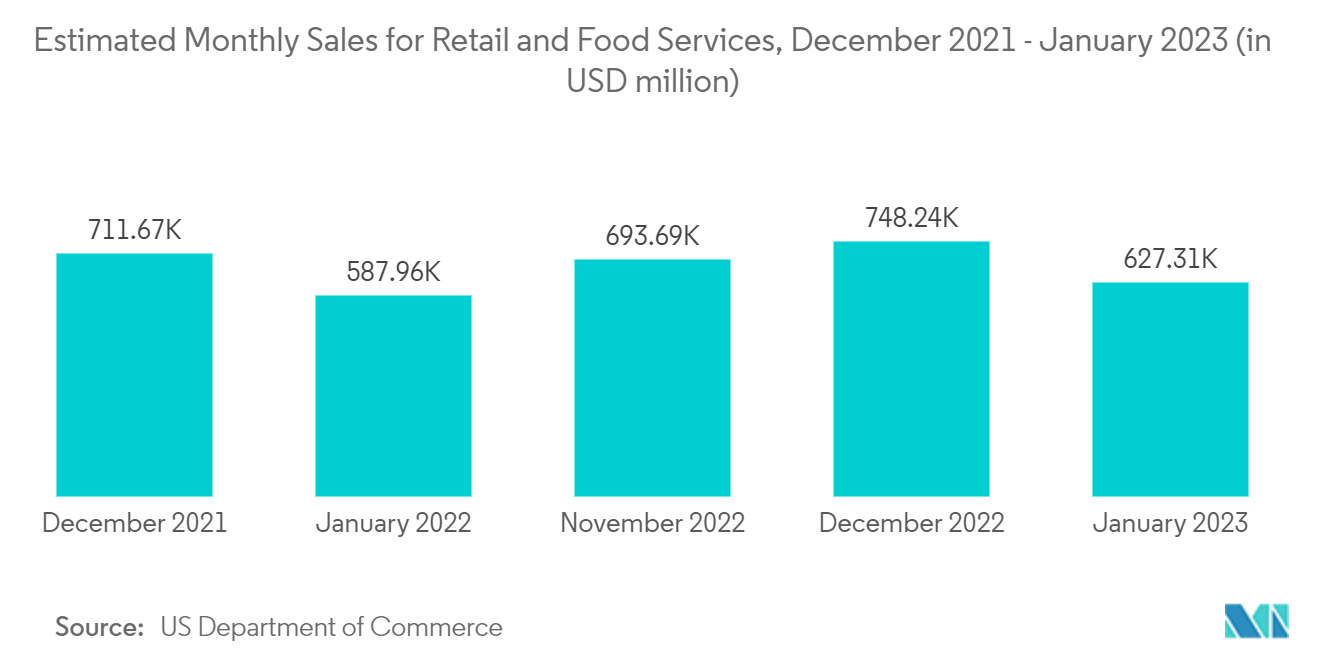
United States is Expected to Hold a Significant Market Share
- The United States is one of the top retail markets globally and was impacted by covid-19. However, returning on track with increasing numbers and bolstering the growth to maintain the boost requires advanced technology to analyze data at that scale. As per the National Retail Federation (NRF), Retail is the nation's largest private-sector employer, contributing USD 3.9 trillion to annual GDP and supporting one in four United States jobs - 52 million working Americans.
- According to the US Census Bureau, total retail sales in March 2022 was up 0.5% seasonally adjusted from February and increased 6.9% Y-O-Y. In February, the rise was 0.8% month over month and 18.2% Y-O-Y.
- The post-pandemic United States retail market has been trying to overcome obstacles using Data Analytics technology as a solution that will be shaped by several factors contributing significantly to how retailers function. Retail analytics solutions for the United States retail industry will focus on dealing with challenges that arise from heightened complexities and help to improve the market share. Their ability to offer actionable insights by analyzing multiple data sets will help their retail clients identify the right strategies for recovering lost sales and boost market share by addressing the dynamic needs of their customers.
- With the market reopening and letting go of lockdown, consumers are shifting to a Hybrid shopping structure, for this omnichannel data is of great significance. A smart omnichannel data and tracking strategy are essential to understanding customers' behavior. Brands with a robust omnichannel business rely on analytics to know how to take advantage of the opportunity possible by customers' behaviors toward the market.
- Furthermore, the country's e-commerce retail and in-store retail sales are likely to propel the industry. According to the US Department of Commerce and the US Census Bureau, e-commerce total U.S. retail sales climbed from 14.5% in the fourth quarter of 2021 to 14.8% in the third quarter of 2022.
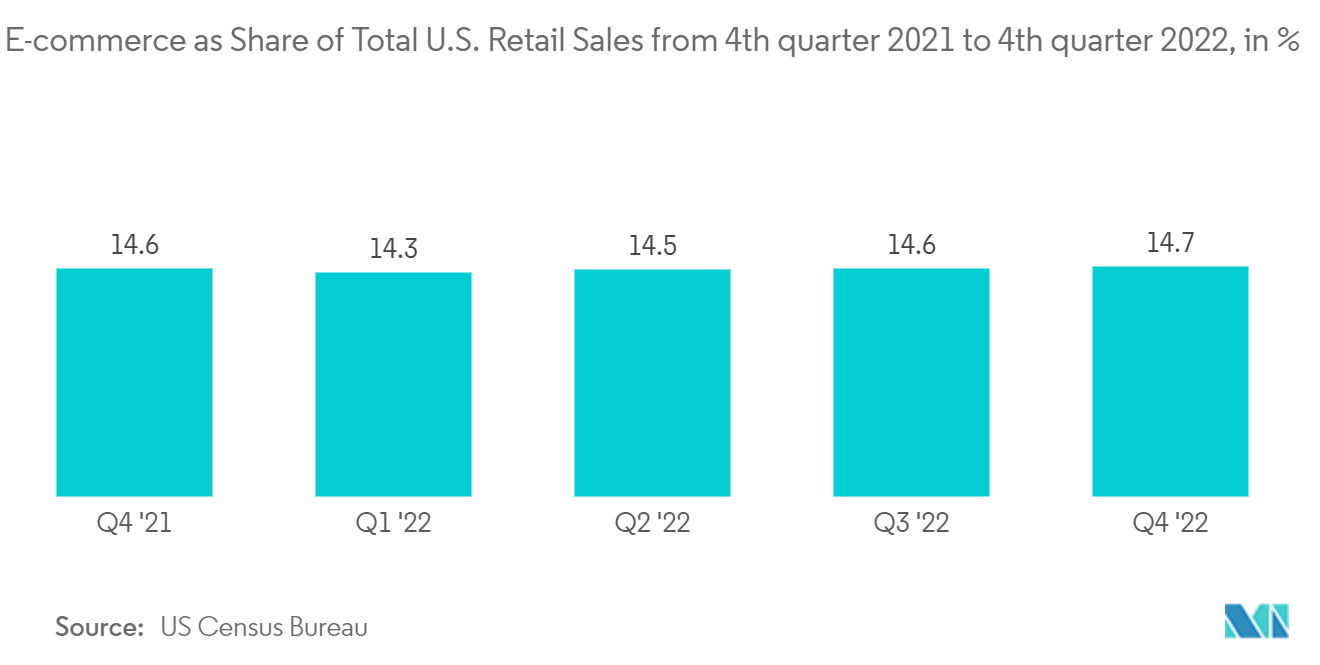
North America In-Store Analytics Industry Overview
The North America in-store analytics market is highly competitive owing to numerous software systems providers and technological innovation in the industry for retail. Some of the major players operating in the market include Capgemini, RetailNext, Happiest Minds Technologies Limited, Capillary Technologies, and ThinkIN, among others. The players in the market are regularly involved in altering their pricing schemes, which creates pricing pressure on other companies, thereby augmenting the competition in the market.
- In October 2023, RetailNext, a provider of in-store traffic analytics, partnered with MarketDial, a prominent A/B testing solution for physical retail. Both companies have made this partnership intending to provide retailers with an unprecedented 360° view of the customer journey. RetailNext uses its AI-driven heat-mapping technology to identify in-store traffic trends, providing actionable insights on dwell time, engagement, and shopper exposure.
- In May 2023, Capgemini and Google Cloud declared an expansion of their long-standing strategic partnership in terms of data analytics and artificial intelligence, thereby building a global Generative AI Google Cloud Center of Excellence to assist enterprises in realizing the complete potential of AI technologies. Capgemini would utilize Google Cloud's generative AI technologies primarily to develop a library of more than 500 enterprise-ready industry use cases, beginning with financial services, retail, as well as automotive.
- In January 2023, Microsoft released a preview of a cloud storage service known as Smart Store Analytics in collaboration with AiFi, which seeks to allow retailers to adopt autonomous shopping technology at a low cost. Smart Store Information, which is part of Microsoft's Clouds for Retail suite of products, offers retailers employing AiFi's technologies operational analytics and shoppers for their fleets of smart shops.
North America In-Store Analytics Market Leaders
-
Capgemini
-
RetailNext
-
Happiest Minds Technologies Limited
-
Capillary Technologies
-
ThinkIN
*Disclaimer: Major Players sorted in no particular order
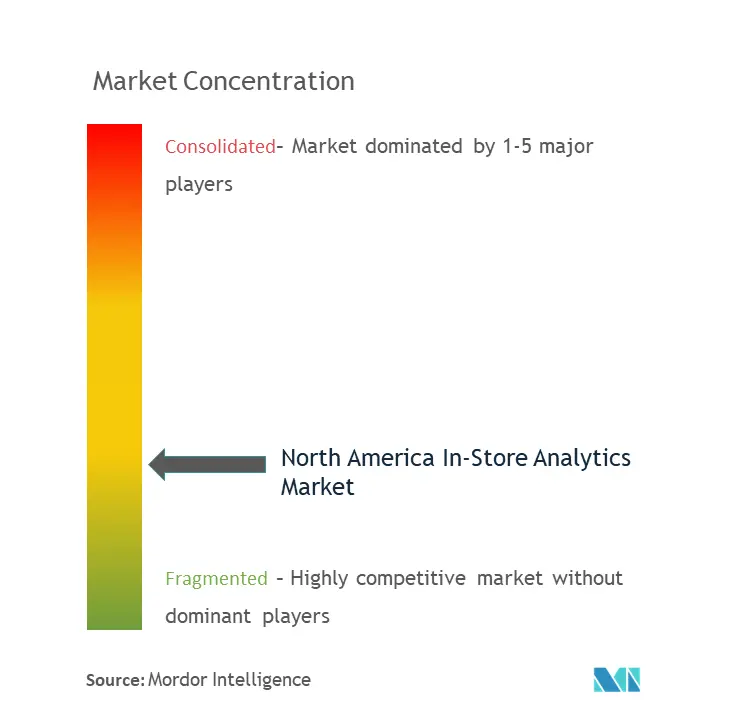
North America In-Store Analytics Market News
- July 2023 - Acosta, an Acosta Group agency and a provider of commerce-centric solutions for the modern marketplace to retailers, brands, and foodservice providers, and Pensa Systems, a provider of digital retail shelf inventory management solutions, have partnered to boost revenue growth for CPG retailers and brands with highly accurate retail shelf visibility, strategic business insights as well as in-store execution. The shelf intelligence of the Pensa brand is being integrated into this new partnership by Acosta's analytics, in-store data collection, business intelligence, and merchandising solutions for all retailers on the market.
- January 2023 - Google Cloud launched four new and upgraded AI technologies designed to help retailers automate in-store inventory checks and improve their e-commerce websites with more seamless and natural shopping experiences for their customers. This new shelf-checking AI solution, built using Google Cloud's Vertex AI Vision, uses Google's database of facts about people, places, and things, enabling retailers to recognize billions of products to ensure in-store shelves are right-sized and well-stocked.
North America In-Store Analytics Market Report - Table of Contents
1. INTRODUCTION
- 1.1 Study Assumptions and Market Definition
- 1.2 Scope of the Study
2. RESEARCH METHODOLOGY
3. EXECUTIVE SUMMARY
4. MARKET INSIGHTS
- 4.1 Market Overview
-
4.2 Industry Attractiveness - Porter's Five Forces Analysis
- 4.2.1 Threat of New Entrants
- 4.2.2 Bargaining Power of Buyers
- 4.2.3 Bargaining Power of Suppliers
- 4.2.4 Threat of Substitutes
- 4.2.5 Intensity of Competitive Rivalry
- 4.3 Industry Value Chain Analysis
- 4.4 Assessment of the Impact of COVID -19 on the Industry
5. MARKET DYNAMICS
-
5.1 Market Drivers
- 5.1.1 Increasing Data Volume In In-store Operations
- 5.1.2 Need For Better Customer Service And Enhanced Shopping Experience
-
5.2 Market Challenges
- 5.2.1 Lack of Skilled Personnel
-
5.3 Use Cases
- 5.3.1 Footfall Analytics
- 5.3.2 Customer Behavior Analytics
- 5.3.3 Loyalty Management
- 5.3.4 Video Analytics
- 5.3.5 Smart Checkouts
6. MARKET SEGMENTATION
-
6.1 By Component
- 6.1.1 Software
- 6.1.2 Services
-
6.2 By Deployment
- 6.2.1 Cloud
- 6.2.2 On-premise
-
6.3 By Organization Size
- 6.3.1 Large Enterprises
- 6.3.2 Small and Medium Enterprises
-
6.4 By Application
- 6.4.1 Customer Management
- 6.4.2 Risk and Compliance Management
- 6.4.3 Store Operation Management
- 6.4.4 Marketing and Merchandizing
- 6.4.5 Other Applications
-
6.5 By Country
- 6.5.1 United States
- 6.5.2 Canada
7. COMPETITIVE LANDSCAPE
-
7.1 Company Profiles
- 7.1.1 Capgemini Se
- 7.1.2 Retailnext Inc.
- 7.1.3 Happiest Minds Technologies
- 7.1.4 Capillary Technologies
- 7.1.5 Thinkin Srl
- 7.1.6 Trax Image Recognition
- 7.1.7 Cloud4wi Inc.
- 7.1.8 Amoobi
- 7.1.9 SAP SE
- 7.1.10 Shoppertrak(sensormatic Solutions)
- 7.1.11 Analytiks AI
- 7.1.12 Cisco Meraki (Cisco Systems Inc.)
- 7.1.13 C2ro
- *List Not Exhaustive
8. INVESTMENT ANALYSIS
9. MARKET OPPORTUNITIES AND FUTURE TRENDS
** Subject To AvailablityNorth America In-Store Analytics Industry Segmentation
In-store analytics refers to the solutions and processes retailers use to measure different metrics, such as foot traffic, dwell time, and conversion rate, among others, within a retail store. Therefore, these solutions enable retailers to address key issues and increase workforce productivity, operations, and better consumer experience through merchandising, among other use cases.
The North American in-store analytics market is segmented by component (software, services), by deployment (cloud, on-premise), by organization size (large enterprises, small and medium enterprises), by application (customer management, risk & compliance management, operation management, merchandise management), and country (United States and Canada). The market sizes and forecasts are provided in terms of value (USD) for all the above segments.
| By Component | Software |
| Services | |
| By Deployment | Cloud |
| On-premise | |
| By Organization Size | Large Enterprises |
| Small and Medium Enterprises | |
| By Application | Customer Management |
| Risk and Compliance Management | |
| Store Operation Management | |
| Marketing and Merchandizing | |
| Other Applications | |
| By Country | United States |
| Canada |
North America In-Store Analytics Market Research FAQs
How big is the NA In-Store Analytics Market?
The NA In-Store Analytics Market size is expected to reach USD 1.38 billion in 2024 and grow at a CAGR of 22% to reach USD 3.72 billion by 2029.
What is the current NA In-Store Analytics Market size?
In 2024, the NA In-Store Analytics Market size is expected to reach USD 1.38 billion.
Who are the key players in NA In-Store Analytics Market?
Capgemini, RetailNext, Happiest Minds Technologies Limited, Capillary Technologies and ThinkIN are the major companies operating in the NA In-Store Analytics Market.
What years does this NA In-Store Analytics Market cover, and what was the market size in 2023?
In 2023, the NA In-Store Analytics Market size was estimated at USD 1.13 billion. The report covers the NA In-Store Analytics Market historical market size for years: 2019, 2020, 2021, 2022 and 2023. The report also forecasts the NA In-Store Analytics Market size for years: 2024, 2025, 2026, 2027, 2028 and 2029.
NA In-Store Analytics Industry Report
Statistics for the 2024 NA In-Store Analytics market share, size and revenue growth rate, created by Mordor Intelligence™ Industry Reports. NA In-Store Analytics analysis includes a market forecast outlook to 2029 and historical overview. Get a sample of this industry analysis as a free report PDF download.



